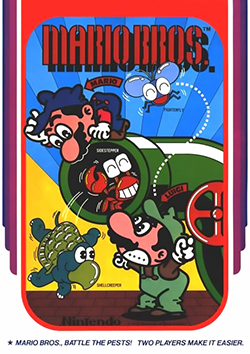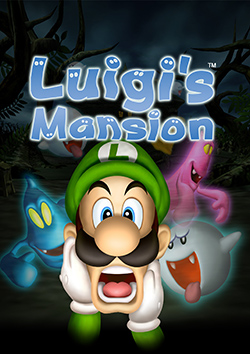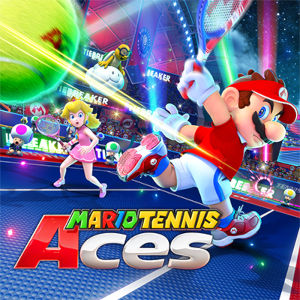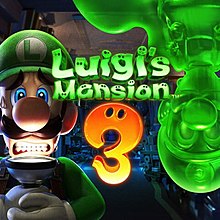Mario Kart is a series of kart racing games and a spin-off Mario franchise developed and published by Nintendo. Players compete in go-kart races while using various power-up items. It features characters and courses mostly from the Mario series as well as other gaming franchises such as The Legend of Zelda, Animal Crossing, F-Zero, Excitebike, and Splatoon.

Mario Bros. is a platform game developed and published by Nintendo as an arcade video game in 1983. It was designed by Shigeru Miyamoto and Gunpei Yokoi, Nintendo's chief engineer. Italian twin brother plumbers Mario and Luigi exterminate creatures, like turtles (Koopas) and crabs emerging from the sewers by knocking them upside-down and kicking them away. The Famicom/Nintendo Entertainment System version is the first game produced by Intelligent Systems. It is part of the Mario franchise, but originally began as a spin-off from the Donkey Kong series.

Luigi's Mansion is a 2001 action-adventure game developed and published by Nintendo. The game was a launch title for the GameCube and was the first game in the Mario franchise to be released for the console; it was released in Japan on September 14, 2001, in North America on November 18, 2001, in Europe on May 3, 2002, and in Australia on May 17, 2002. It is the third video game in which Luigi is the main character instead of Mario, after Mario Is Missing! and Luigi's Hammer Toss. Players control him as he explores a haunted mansion, searches for Mario and deals with ghosts by capturing them through a vacuum cleaner supplied by Professor E. Gadd.

Luigi is a fictional character featured in video games and related media released by Nintendo. Created by Japanese video game designer Shigeru Miyamoto, Luigi is portrayed as an Italian plumber and the younger fraternal twin brother and sidekick of Mario. Defined by his kind-hearted, yet cowardly demeanor, Luigi appears in many games throughout the Mario franchise, oftentimes accompanying his brother.

Super Mario is a platform game series created by Nintendo starring their mascot, Mario. It is the central series of the greater Mario franchise. At least one Super Mario game has been released for every major Nintendo video game console. However, there have also been a number of Super Mario video games released on non-Nintendo gaming platforms. There are more than 20 games in the series.

Mario Strikers Charged is a 2007 sports video game developed by Canadian developer Next Level Games and published by Nintendo for the Wii. It is a sequel to Super Mario Strikers for the GameCube. It was released on May 25, 2007 in Europe, June 7, 2007 in Australia, July 30, 2007 in North America, September 20, 2007 in Japan, and March 18, 2010 in Korea.

Mario is a Japanese multimedia franchise created by Japanese game designer Shigeru Miyamoto for video game company Nintendo, which produces and publishes its installments. Starring the titular Italian plumber Mario, it is primarily a video game franchise but has extended to other forms of media, including television series, comic books, a 1993 feature film, a 2023 animated film, and theme park attractions. The series' first installment was 1983's Mario Bros., although Mario made his first appearance in 1981's arcade game Donkey Kong and had already been featured in several games of the Donkey Kong and Game & Watch series. The Mario games have been developed by a wide variety of developers, including Nintendo, Hudson Soft, and AlphaDream. Mario games have been released almost exclusively for Nintendo's various video game consoles and handhelds, from the third generation onward.

Toad, known in Japan as Kinopio, is a fictional character who primarily appears in Nintendo's Mario franchise. A humanoid with a mushroom-like head, Toad was created by Japanese video game designer Shigeru Miyamoto, and is portrayed as a citizen of the Mushroom Kingdom and is one of Princess Peach's most loyal attendants, constantly working on her behalf. Toad is usually seen as a non-player character who provides assistance to Mario and his friends in most games, but there are times when Toad takes center stage and appears as a protagonist, as seen in Super Mario Bros. 2, Wario's Woods and Super Mario 3D World.

Luigi's Mansion: Dark Moon is a 2013 action-adventure video game developed by Next Level Games and published by Nintendo for the Nintendo 3DS. It is the sequel to the 2001 Nintendo GameCube game Luigi's Mansion, and the third Mario franchise game where Luigi plays the lead role instead of the usual protagonist, Mario. The story follows Luigi as he explores a series of mansions in Evershade Valley, capturing ghosts using a specialized vacuum cleaner invented by Professor E. Gadd. In order to restore peace to Evershade Valley, Luigi must collect the pieces of the Dark Moon and recapture the main antagonist, King Boo.

New Super Mario Bros. U is a 2012 platform game developed and published by Nintendo as a launch title for the Wii U. The game is a sequel to New Super Mario Bros. Wii and is the first entry in the Super Mario series to feature high-definition graphics.

Nintendo Land is a party video game developed and published by Nintendo as a pack-in launch title for the Wii U home video game console in 2012. The game was first announced at E3 2012 during Nintendo's press conference.

Mario Kart 8 is a 2014 kart racing game developed and published by Nintendo for the Wii U. It retains the gameplay of previous games in the Mario Kart series, with players controlling a Mario franchise character in races around tracks. Tracks are themed around locales from the Super Mario platform series and are populated with power-ups that help players gain advantages in races. Different difficulties are selectable prior to a race; harder difficulties make gameplay faster. In the new anti-gravity sequences, players drive on walls and ceilings. Mario Kart 8 contains a variety of single-player and local and online multiplayer games modes, including Grand Prix racing and arena-based battle modes.

Super Mario 3D World is a 2013 platform game developed and published by Nintendo for the Wii U. It is the sixth original 3D platform game in the Super Mario series and the sequel to Super Mario 3D Land (2011) for the Nintendo 3DS.

The Year of Luigi was the 30th-anniversary celebration of the fictional character Luigi. He was created by Japanese video game designer Shigeru Miyamoto for the 1983 arcade game Mario Bros. and has appeared frequently as a minor or supporting character in the Mario franchise since. Due to Nintendo's decision to develop Luigi's Mansion: Dark Moon and Mario & Luigi: Dream Team at the same time, they declared 2013 the Year of Luigi. According to Mario creator Shigeru Miyamoto, Nintendo staff members also had the urge to develop games focused on Luigi, and considered the character underrepresented compared to Mario. It was announced via Nintendo Direct on February 14, 2013, by Nintendo CEO Satoru Iwata and ended on March 18, 2014.

Mini Mario & Friends: Amiibo Challenge is a 2016 puzzle-platform game developed and published by Nintendo for the Nintendo 3DS and Wii U. The seventh entry in the Mario vs. Donkey Kong series, the game was free to download on the Nintendo eShop, but requires Nintendo's Amiibo lineup in order to play. It was released in Japan in January 2016 and worldwide in April.

Mario Tennis Aces is a 2018 tennis game developed by Camelot Software Planning and published by Nintendo for the Nintendo Switch. The game is part of the Mario Tennis series and sold over four million copies by the end of 2021, making it one of the best-selling games on the Switch. The game received generally favorable reviews from critics.

Super Mario Party is a party video game developed by NDcube and published by Nintendo for the Nintendo Switch. The eleventh main entry in the Mario Party series, the game was described as a "complete refresh" of the franchise, bringing back and revitalizing gameplay elements from older titles while also introducing new ones to go along with them. It was released worldwide on 5 October 2018 and sold 1.5 million copies by the end of the month. As of December 31, 2023, the game has sold more than 20.34 million copies worldwide, making it one of the top ten best-selling games on the system. Mario Party Superstars, a game featuring maps remastered from earlier entries and a return to the original formula, was released in 2021.

Super Mario Maker 2 is a 2019 platform game and game creation system developed and published by Nintendo for the Nintendo Switch. It is the sequel to Super Mario Maker and was released worldwide on June 28, 2019. The gameplay is largely retained from that of its predecessor, in which players create their own custom courses using assets from various games across the Super Mario franchise and share them online. Super Mario Maker 2 introduces new features and course assets, including a single player story mode and new level assets based on Super Mario 3D World.

















